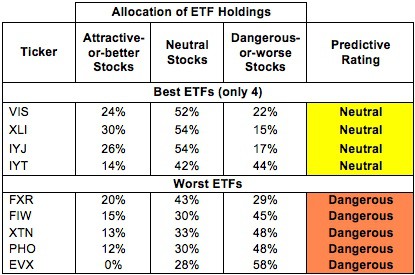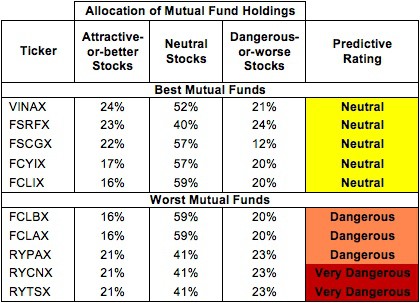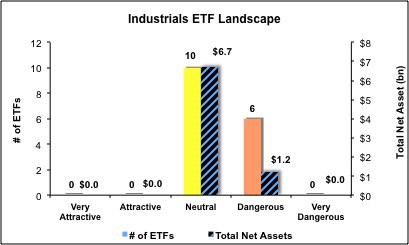The Industrials sector ranks fourth out of the ten sectors as detailed in my Sector Rankings for ETFs and Mutual Funds report. It gets my Neutral rating, which is based on aggregation of ratings of 16 ETFs and 24 mutual funds in the Industrials sector as of April 17, 2013. Prior reports on the best & worst ETFs and mutual funds in every sector and style are here.
Figure 1 ranks from best to worst the nine Industrials ETFs that meet our liquidity standards and Figure 2 shows the five best and worst-rated Industrials mutual funds.
Not all Industrials sector ETFs and mutual funds are created the same. The number of holdings varies widely (from 20 to 366), which creates drastically different investment implications and ratings. The best ETFs and mutual funds allocate more value to Attractive-or-better-rated stocks than the worst ETFs and mutual funds, which allocate too much value to Neutral-or-worse-rated stocks.
To identify the best and avoid the worst ETFs and mutual funds within the Industrials sector, investors need a predictive rating based on (1) stocks ratings of the holdings and (2) the all-in expenses of each ETF and mutual fund. Investors need not rely on backward-looking ratings.
My fund rating methodology is detailed here.
Investors should not buy any Industrials ETFs or mutual funds because none get an Attractive-or-better rating. If you must have exposure to this sector, you should buy a basket of Attractive-or-better rated stocks and avoid paying undeserved fund fees. Active management has a long history of not paying off.
Get my ratings on all ETFs and mutual funds in this sector on my free mutual fund and ETF screener.
Figure 1: ETFs with the Best & Worst Ratings – Top 5
* Best ETFs exclude ETFs with TNAs less than $100 million for inadequate liquidity.
Sources: New Constructs, LLC and company filings
ITA, RGI, PPA, and UXI are excluded from Figure 1 because their total net assets (TNA) are below $100 million and do not meet our liquidity standards.
Figure 2: Mutual Funds with the Best & Worst Ratings – Top 5
* Best mutual funds exclude funds with TNAs less than $100 million for inadequate liquidity.
Sources: New Constructs, LLC and company filings
PGILX, ICTRX, and RYPIX are excluded from Figure 2 because their total net assets (TNA) are below $100 million and do not meet our liquidity standards.
Industrial Select Sector SPDR (XLI) is my top-rated Industrials ETF and Vanguard Industrials Index Fund (VINAX) is my top-rated Industrials mutual fund. Both earn my Neutral rating.
Market Vectors Environmental Services ETF (EVX) is my worst-rated Industrials ETF and Rydex Series Funds: Transportation Fund (RYTSX) is my worst-rated Industrials mutual fund. EVX earns my Dangerous rating and RYTSX earns my Very Dangerous rating.
Figure 3 shows that 78 out of the 467 stocks (over 25% of the market value) in Industrials ETFs and mutual funds get an Attractive-or-better rating. However, no Industrials ETFs or mutual funds get an Attractive-or-better rating.
The takeaway is: mutual fund managers allocate too much capital to low-quality stocks and Industrials ETFs hold poor quality stocks.
Figure 3: Industrials Sector Landscape For ETFs, Mutual Funds & Stocks
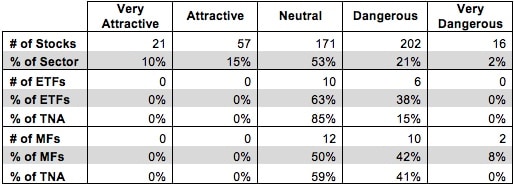 Sources: New Constructs, LLC and company filings
Sources: New Constructs, LLC and company filings
As detailed in “Cheap Funds Dupe Investors”, the fund industry offers many cheap funds but very few funds with high-quality stocks, or with what I call good portfolio management.
Investors need to tread carefully when considering Industrials ETFs and mutual funds, as 6 ETFs and 12 mutual funds earn a Dangerous-or-worse rating. No ETFs or mutual funds in the Industrials sector allocate enough value to Attractive-or-better-rated stocks to earn an Attractive rating. Investors seeking exposure to this sector should focus on individual stocks instead.
United Parcel Service, Inc. (UPS) is one of my favorite stocks held by Industrials ETFs and mutual funds and earns my Very Attractive rating. UPS has a top-quintile return on invested capital (ROIC) of 23%. The company has grown after tax profit (NOPAT) by 10% compounded annually for the past 13 years. Though the underfunding of its pension plan is a concern, UPS has $5 billion in excess cash and a healthy free cash flow that should allow it to handle that liability. The market valuation of UPS, on the other hand, is quite pessimistic. UPS is currently valued at ~$83.22/share, giving it a price to economic book value ratioof 0.8. This low valuation implies that the company’s NOPAT will permanently decline by 20%. Such a bleak expectation is unwarranted for a company with the track record of UPS. Large cash flows at a low price makes UPS a solid investment.
Southwest Airlines (LUV) is one of my least favorite stocks held by Industrials ETFs and mutual funds and earns my Very Dangerous rating. Over the past decade LUV has not earned an ROIC above 6%. It has earned negative economic earnings in 13 out of the past 14 years. The company also has over $4 billion (35% of net assets) in off-balance sheet debt due to operating leases. High debt and low, stagnant returns make LUV risky to investors. Normally such risk makes a company very cheap, but that is not the case for LUV. The current share price of ~$13.18 implies 7% NOPAT growth compounded annually over 21 years. It’s no secret that the airline business is a difficult one to make money in. Expecting LUV to achieve such high, long-term growth is risky business.
415 stocks of the 3000+ I cover are classified as Industrials stocks, but due to style drift, Industrials ETFs and mutual funds hold 467 stocks.
Figures 4 and 5 show the rating landscape of all Industrials ETFs and mutual funds.
My Sector Rankings for ETFs and Mutual Funds report ranks all sectors and highlights those that offer the best investments.
Figure 4: Separating the Best ETFs From the Worst ETFs
Sources: New Constructs, LLC and company filings
Figure 5: Separating the Best Mutual Funds From the Worst Mutual Funds
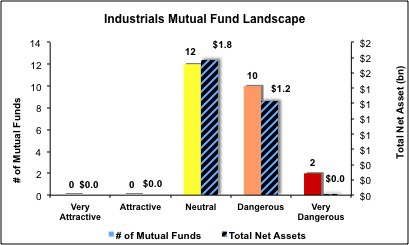 Sources: New Constructs, LLC and company filings
Sources: New Constructs, LLC and company filings
Review my full list of ratings and rankings along with reports on all 16 ETFs and 24 mutual funds in the Industrials sector.
Sam McBride contributed to this report
Disclosure: David Trainer owns UPS. David Trainer and Sam McBride receive no compensation to write about any specific stock, sector or theme.

